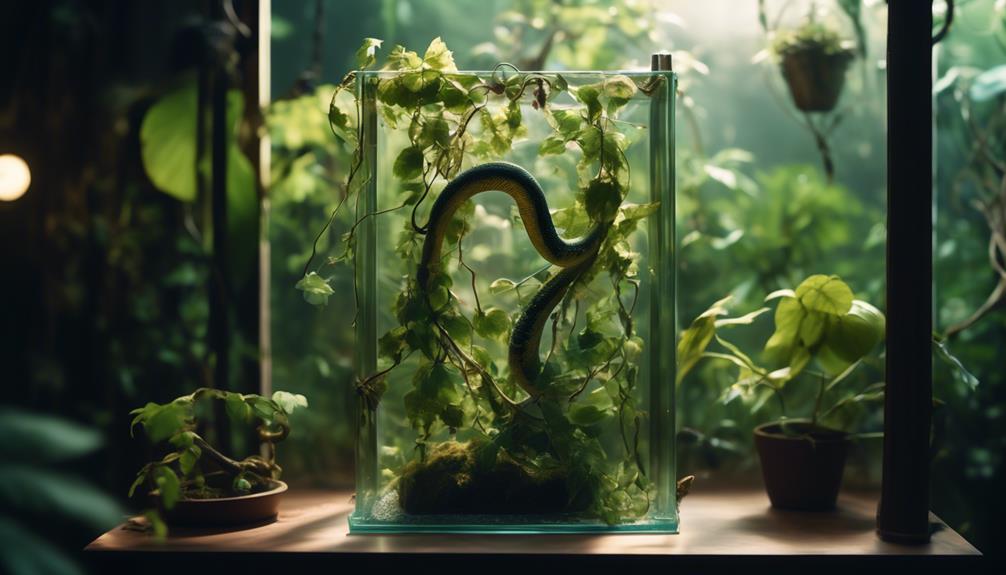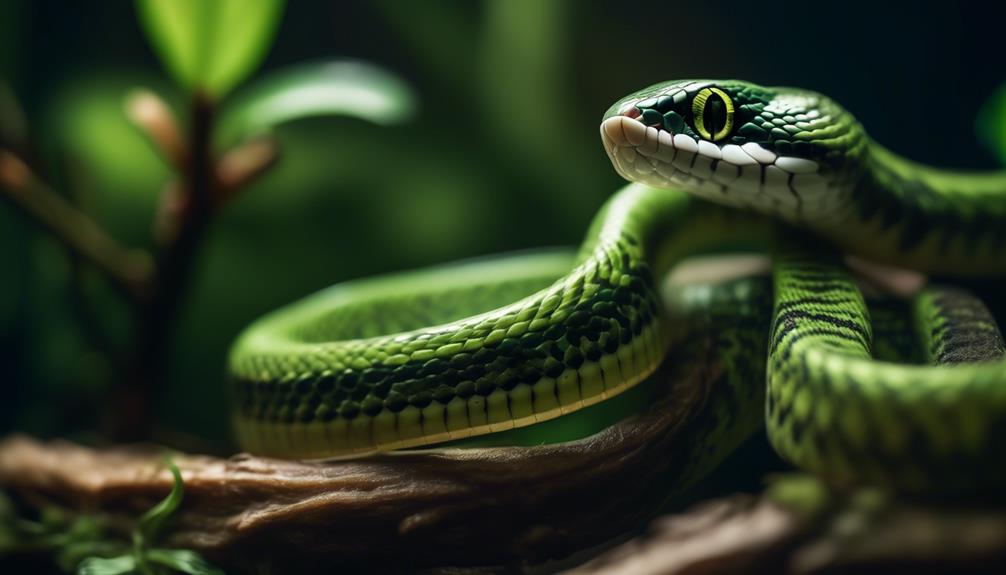Are you ready to unlock the secrets of mastering vine snake care? Like a hidden treasure waiting to be discovered, these mesmerizing creatures offer a world of wonder and fascination.
As experienced snake keepers, we understand the importance of providing the best care possible for these unique reptiles. In this discussion, we will share essential tips and techniques that will help you create the perfect environment for your vine snake.
From enclosure requirements to feeding and handling, we will guide you through every step of the way. So, get ready to embark on this journey with us, and let's unravel the mysteries of vine snake care together.
Key Takeaways
- Provide a spacious enclosure with dimensions larger than the minimum requirement for the well-being of vine snakes.
- Use UVB lighting, such as Zoo Med Reptisun T5 HO 5.0 or Arcadia Forest 6%, to ensure optimal health and well-being.
- Maintain appropriate temperature levels, with a basking surface temperature between 95-100°F and lower levels between 78-85°F.
- Create a suitable humidity level of 60-100% by using a humid hide lined with moistened sphagnum moss and using recommended substrates like Zoo Med Eco Earth or Exo Terra Plantation Soil.
Enclosure Requirements

To ensure the well-being of vine snakes, it's crucial to provide them with appropriate enclosure dimensions and avoid cohabitation with other snakes.
When it comes to enclosure size, the minimum dimensions should be 6 feet in length, 3 feet in width, and 6 feet in height. However, larger dimensions are highly beneficial for the snake's overall well-being.
Vine snakes aren't social species, so keeping them together causes competition and stress. Therefore, it's recommended to house them individually.
When it comes to enclosure decorations, it's important to create a natural and stimulating environment. Adding branches, vines, and foliage will allow them to exhibit their natural behaviors and provide opportunities for climbing and perching. These decorations should be securely placed to ensure the safety of the snake.
Lighting and Temperature
For optimal health and well-being, vine snakes require proper lighting and temperature in their enclosure. The right lighting setup and temperature regulation techniques are essential to create a habitat that mimics their natural environment. Vine snakes require UVB lighting to meet their UVB needs and ensure proper calcium metabolism. Recommended UVB bulbs for vine snakes include the Zoo Med Reptisun T5 HO 5.0 and the Arcadia Forest 6%. It is important to maintain a basking surface temperature between 95-100°F, while the lower levels of the enclosure should be between 78-85°F. During the nighttime, the temperature can drop down to 72-76°F. By providing the optimal lighting and temperature conditions, you can ensure the well-being and health of your vine snake.
| Aspect | Recommendation |
|---|---|
| UVB Lighting | Zoo Med Reptisun T5 HO 5.0, Arcadia Forest 6% |
| Basking Temperature | 95-100°F |
| Lower Level Temperature | 78-85°F |
| Nighttime Temperature | 72-76°F |
Humidity and Substrate

Maintaining the appropriate humidity levels and selecting the right substrate are crucial for the well-being and health of vine snakes.
Humidity control is essential as it helps replicate the natural environment of vine snakes and ensures proper hydration. To maintain the ideal humidity of 60-100%, it's recommended to install a humid hide lined with moistened sphagnum moss. This provides a microclimate for the snake to retreat to when it needs higher humidity.
Choosing the right substrate is also important as it helps with moisture retention and provides a suitable surface for the snake to move on. Some recommended substrates for vine snakes include Zoo Med Eco Earth, Zoo Med ReptiSoil, Exo Terra Plantation Soil, and Zilla Jungle Mix.
It's important to ensure that the substrate is at least 2 inches deep and replaced every 3-4 months to prevent bacterial growth and maintain cleanliness in the enclosure.
Feeding and Handling
As we move on to discussing the subtopic of Feeding and Handling, it's important to ensure that the dietary needs of vine snakes are met and that proper handling techniques are used to minimize stress and ensure the snake's well-being.
Vine snakes are carnivorous and eat small rodents, so offering them appropriately sized prey items is crucial. Prey sizes should be proportional to the size of the snake, ensuring that it can be swallowed whole without difficulty. It's recommended to feed vine snakes once every 7-10 days to maintain their nutritional needs.
When it comes to handling, vine snakes are generally docile but can be nervous. To avoid causing unnecessary stress, it's important to use gentle and slow movements when handling them.
Health, Maintenance, and Reproduction

To ensure the health, maintenance, and successful reproduction of vine snakes, it's essential to regularly monitor their overall well-being and implement proper care practices. Here are some important points to consider:
- Checking for Signs:
- Regularly check for signs of illness or injury, such as changes in behavior, loss of appetite, or abnormal shedding.
- If you notice any signs of illness or injury, consult a veterinarian who specializes in reptiles.
- Mating Behavior:
- Mating season for vine snakes typically occurs during the rainy season.
- Female vine snakes will lay eggs after mating, and the incubation period is around 60-70 days.
Maintaining a clean enclosure is crucial to prevent bacterial growth and ensure the snake's well-being. Additionally, closely monitor the shedding process and provide the proper humidity levels to facilitate a successful shed.
Frequently Asked Questions
What Are Some Common Health Issues That Vine Snakes May Experience?
Common health issues that vine snakes may experience include respiratory infections, parasites, and shedding problems. Preventive measures include maintaining proper humidity and temperature, regular check-ups, and providing a clean enclosure. Treatment options may involve medication and veterinary care.
Can Vine Snakes Be Kept in a Glass Enclosure or Do They Require a Different Type of Enclosure?
Glass enclosures can be used for vine snakes, but they may not be the most suitable option. Larger dimensions and proper ventilation are essential for their well-being. Other enclosures like PVC or wooden vivariums are better choices.
Are Vine Snakes Venomous?
Vine snakes are non-venomous. Understanding the difference between venomous and non-venomous snakes is crucial for handling them safely. It's important to approach vine snakes with caution and use proper techniques to minimize stress.
How Long Do Vine Snakes Typically Live in Captivity?
Vine snakes typically live around 8-12 years in captivity with proper care. To ensure their well-being, we recommend following vine snake care tips such as providing the right enclosure, lighting, temperature, humidity, substrate, feeding, handling, and monitoring their health and reproduction.
Do Vine Snakes Require Any Specific Supplements or Vitamins in Their Diet?
Vine snakes do not require any specific supplements or vitamins in their diet. However, it is important to provide them with a varied and balanced diet of small rodents to meet their specific dietary requirements. Feeding should be done once every 7-10 days.
Conclusion
In conclusion, by following the essential tips and techniques outlined in this article, you can become a master in vine snake care.
Remember, caring for these mesmerizing reptiles is like tending to a delicate garden.
With the right enclosure, lighting, temperature, humidity, substrate, feeding, handling, and health maintenance, you can create a thriving environment for your vine snakes to flourish and thrive.
So, embrace the journey and let your passion for these captivating creatures bloom like a beautiful vine in your care.


